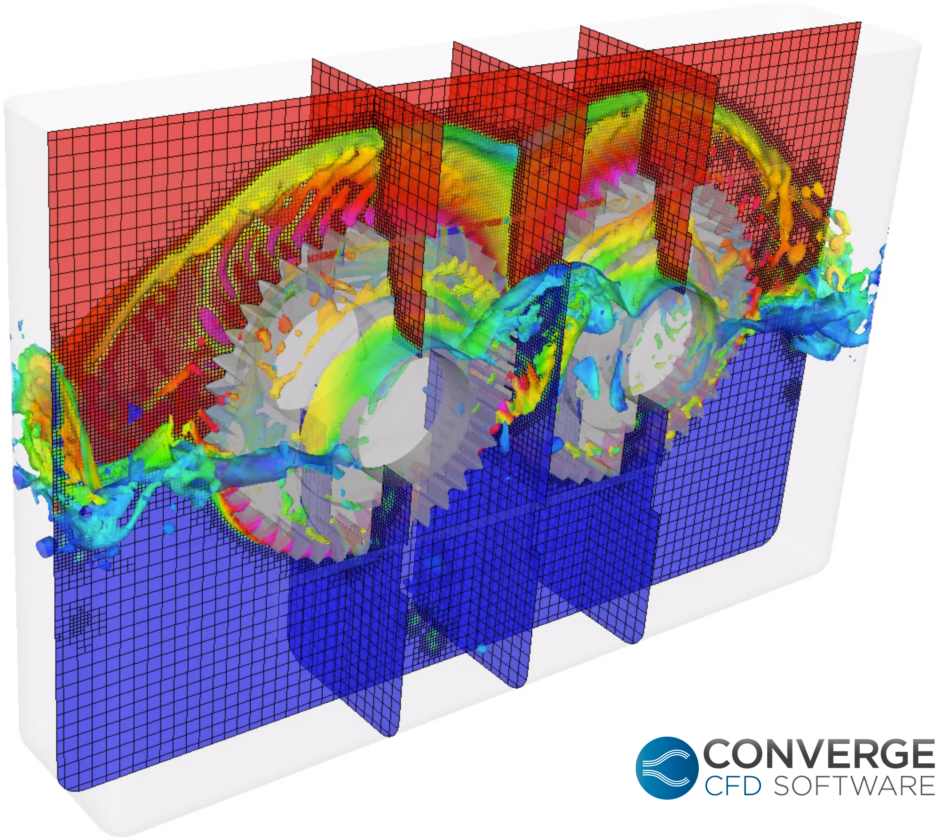
Volume of Fluid
Modeling Multi-Phase Flows

Multi-phase flows are abundant in engineering applications, from dip-lubricated gearboxes and jets in crossflow to liquid sloshing in tanks and internal nozzle flow in fuel injectors. However, numerically modeling multi-phase flows is a challenge. There is a large difference in density between the phases, and resolving a sharp interface—especially over a long period of time—can incur a prohibitively high computational cost. CONVERGE’s volume of fluid (VOF) method is an Eulerian-Eulerian approach for modeling multi-phase flows. With autonomous meshing and a variety of interface tracking schemes, CONVERGE’s VOF method can efficiently and accurately simulate multi-phase flows, even in complex geometries with moving boundaries.
Maintain a Sharp Interface
CONVERGE includes several approaches to help capture a sharp fluid-fluid interface in a VOF simulation. The High Resolution Interface Capturing (HRIC) scheme maintains a balance between accuracy and stability and can be used with both compressible and incompressible fluids. For incompressible flows, the Piecewise Linear Interface Calculation (PLIC) can maintain a sharper interface than HRIC and can accurately resolve topological changes.
Flux-corrected transport (FCT) limits diffusive and dispersive numerical errors to help maintain a sharp interface between fluids. This approach can be used for both compressible and incompressible flows and with any number of liquid and gas species. Surface compression, a surface sharpening technique that reduces numerical diffusion at fluid interfaces, is useful for achieving visually realistic results as it allows you to capture smaller-scale structures. Like FCT, surface compression can be used for both compressible and incompressible flows and with any number of liquid and gas species. You can also use FCT and surface compression together to achieve an even sharper interface if your application requires it.
The mixture model can be used to separate fluids that are mixed together. Each species can have a separate drift velocity, and thus the mixture model can simulate the separation of phases or immiscible liquids due to gravity or inertial effects. You can additionally use the mixture model to simulate phenomena such as pneumatic transport and bubbly, slurry, or droplet/particle-laden flows.
Furthermore, the mixture model can be used either on its own or in conjunction with FCT to reduce numerical diffusion and maintain a sharp interface during a VOF simulation. The mixture model works for both compressible and incompressible flows and with any number of liquid and gas species. When using the mixture model, you have the option to enable the long-scale interface model, which determines the fluid cells for which the mixture model can be turned off. The long-scale interface model can significantly reduce the computational cost of the simulation.
Adaptive Mesh Refinement
In CONVERGE, you don’t have to trade speed for accuracy. You can accelerate your simulation by coupling CONVERGE’s VOF method with Adaptive Mesh Refinement (AMR) to automatically increase grid resolution at the fluid-fluid interface based on the local void fraction. AMR reduces numerical diffusion and helps you resolve the interface at a reasonable computational cost, even over a long period of time, by adding cells only when and where you need them.
VOF-Spray One-Way Coupling
The VOF method is ideal for detailed multi-phase modeling of internal flow in injectors, but resolving the ensuing spray breakup phenomena using the Eulerian-Eulerian model is computationally expensive. VOF-spray one-way coupling in CONVERGE allows you to simulate the internal and near-nozzle regions of the injectors with the VOF method, then initialize an Eulerian-Lagrangian spray model using the VOF data. The VOF model captures differences between nozzles due to surface effects and needle motion, and the Lagrangian parcel simulation incorporates spray breakup, collision, drag, and evaporation in a model that runs more efficiently.






